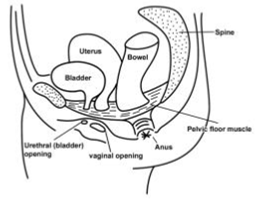Physiotherapy – Improving your Pelvic Health and fitness after pregnancy
Improving your Pelvic Health and fitness after pregnancy
This leaflet will explain the importance of ensuring good pelvic health including what the pelvic floor muscles do and how to exercise them, what symptoms to look out for after having a baby and how to access help and support if things ‘aren’t right’. It also gives guidance on how and when to start exercise safely after having your baby.
You will want to give your baby lots of attention following delivery, but it is also important to take time for yourself to allow your body to recover. It is likely that your physical recovery will take time, but there are gentle exercises that you can start to help get yourself back into shape. You can start these exercises from day 1 if you feel ready, but it is important to start gently and build up slowly. By regaining your fitness you may notice that you have more energy, and this can also help to prevent future health problems.
This leaflet gives advice and information on exercises that will help you get back into shape after the birth of your baby.
The Pelvic Floor
The pelvic floor is a group of muscles, which lie like a hammock at the base of the pelvis, running from the pubic bone at the front to the tailbone at the back.
These muscles support the pelvic organs (bladder, uterus / womb and bowels) and help control the bladder and bowels. They work with the abdominal muscles to help support the spine and may also help with sex.
Both the abdominal and pelvic floor muscles can become weaker during pregnancy, so it is important to strengthen them after delivery to prevent symptoms of pelvic floor dysfunction.

Illustrated diagram of pelvic floor
Symptoms to look out for:
- Leaking urine (wee) on coughing, sneezing, lifting or running (even small amounts)
- Sudden urgent or frequent need to pass urine (wee)
- Feeling ‘something coming down’ or a ‘dragging sensation’ in the vagina – (prolapse)
- Being unable to control leakage of wind or ‘poo’ from the bowel
- Lack of sensation with sex
- Pain with sex
If you have a catheter, wait until it has been removed before you start your pelvic floor exercises.
If you have stitches, you can still do these exercises as they will help with the healing and reduce swelling in the area, but it is important to start gently in the first few days after delivery.
How do I find my pelvic floor muscles?
It is important to know you are exercising the right pelvic floor muscles.
Find a comfortable position sitting upright with your feet flat on the floor or alternatively lying on your back or side with your knees bent.
Imagine that you are trying to stop yourself passing wind and urine at the same time, drawing the muscles upwards and forwards starting from the back passage.
It is important not to hold your breath.
Try not to clench / squeeze the buttock muscles or hold your breath.
How to exercise the pelvic floor muscles
Pelvic floor exercises should include long squeezes as well as short, quick squeezes, making sure you let go/relax the muscle between each squeeze. Aim to complete both long and short squeezes 3 times a day.
Don’t try to stop and start the flow of urine whilst on the toilet – this can interfere with normal bladder function.
Long squeezes
- To begin, aim to hold the squeeze for 5 seconds. Let go. Relax for a few seconds.
- Repeat 5 times.
- As the muscle gets stronger, aim to hold for up to 10 seconds and up to 10 repetitions.
Short, quick squeezes
- Quickly squeeze the pelvic floor and then let go immediately.
- To begin with, aim to repeat 5 short squeezes. Make sure you relax the pelvic floor between each squeeze. As the muscle gets stronger, aim for 10 short squeezes.
Exercises for your abdominal (tummy) muscles
The transverse abdominals are the deepest abdominal muscles, and these help to support your back and help with your posture. There is a simple exercise that you can start doing to engage these muscles.
Illustration of lying on your back with your knees bent up
Lie on your back with your knees bent up, feet on the floor and your hand on the lower part of your tummy. Gently breathe in so you can see and feel your tummy rise, and as you breath out, draw the lower part of your tummy in towards your spine. Hold this for 3-4 seconds, making sure not to hold your breath, and then relax fully. Repeat this 5 times, aiming to gradually increase the time you hold the muscles in.

Illustration of how to do knee rolls
Knee Rolls: Lie on your back with your knees bent up and feet flat on the bed/floor. Draw in your Transverse Abdominals, keep your knees and feet together and allow your knees to roll to the right as far as is comfortable. Return to the middle and relax, before repeating the exercise to the left. Try 3 times to each side.
Pelvic Tilts: Draw in your lower tummy muscles (transverse abdominals) and contract your pelvic floor muscles at the same time. Hollow your tummy, allowing your back to flatten into the bed and your pelvis to tilt. Hold this position for 3 seconds whilst breathing normally, and gently release. Repeat this up to 10 times.
Pelvic tilts are helpful to reduce any lower back pain and also increase the strength of your abdominal muscles.
Avoid full sit-ups until your tummy muscles are fully recovered and back to your usual strength. If you see or feel a central bulge in your tummy when you sit up from lying down, ask your midwife or GP to refer you to the Pelvic Health Physiotherapy service.
General Advice
For healthy bladder, bowel and pelvic floor muscles
- If you are doing these exercises after delivery and you have a catheter (a tube to empty your bladder) make sure you wait for the catheter to be removed before starting pelvic floor exercises
- Pelvic floor exercises can be started gently on the first day after you have your baby – whether the birth was vaginal or by c-section – unless you are told otherwise
- Try to tighten your pelvic floor muscles prior to any activity that requires effort (e.g. coughing, sneezing, lifting – washing/hoovers or your baby!) to prevent leakage of urine and vaginal prolapse
- Ensure each pelvic floor contraction is fully relaxed before doing the next
- Avoid caffeinated drinks (e.g. tea, green, tea, coke, energy drinks) and fizzy drinks as they can irritate the bladder
- Try to drink 1.5-2 litres of fluids a day but remember if it is very hot or you are breastfeeding you must increase the amount of fluid you drink
- Download the NHS Squeezy App available on all smartphones and mobile devices to help you to do the exercises – remember to reduce the pre-set programme to the programme overleaf
- Avoid constipation by drinking adequate fluids, taking regular exercise (just walking helps) and eating a good, varied diet containing fruit, vegetables and wholegrains (e.g. brown rice/porridge). Speak to your GP if it is a long-standing problem.
For back pain and general fitness
- It can take up to 6 months for your pelvic joints to recover post-delivery and in this time it can be easy to strain your back, particularly if you are doing lots of lifting.
- Backache can be common in new mothers, so it is important to pay attention to your feeding position (breast or bottle feeding), making sure that your back is well supported.
- It is important to continue to work on the strength of your abdominal and pelvic floor muscles, as these are important in protecting your back from injury.
- Make sure that you engage your abdominal and pelvic floor muscles when doing activities such as lifting, bending, or standing for a long period of time.
- Walking for a short distance every day will help to improve your strength and fitness, and you should try to increase the pace and distance achieved as you feel able.
For some mothers, return to formal exercise is important for both physical and mental health while others want to start something new, however it is also essential to allow your postnatal body to recover fully before starting higher load or demanding exercise (e.g. running, HIIT, zumba and weights) to prevent long term damage to your pelvic floor.
More guidance is available with the ‘Return to running guidelines’ downloadable for free from (PDF) Returning to running postnatal – guidelines for medical, health and fitness professionals managing this population (researchgate.net) . It incorporates a structured pathway for safe progression of exercises for those that have no concerns regarding pelvic floor dysfunction – symptoms described above.
For more information on returning to exercise visit: www.thepogp.co.uk and their information booklet ‘Fit for the Future’.
When to get help?
Should you continue to have bladder (wee) leakage during pregnancy or after having your baby you can find further advice and resources on our website: www.bedfordshirehospitals.nhs.uk/our-services/maternity-2/pelvic-health/ or scan the QR code.

QR code leads to pelvic health section of Trust website
Alternatively, with any of these symptoms or others including prolapse, bowel urgency or leakage (wind or poo) or pain from your stitches (after 6 weeks) or with sex you can ask your GP, health visitor or midwife to refer you to our service.
We ask for information about you so that you can receive proper care and treatment. This information remains confidential and is stored securely by the Trust in accordance with the provisions of the Data Protection Act 2018/GDPR. Further guidance can be found within our privacy notice found on our Trust website:
